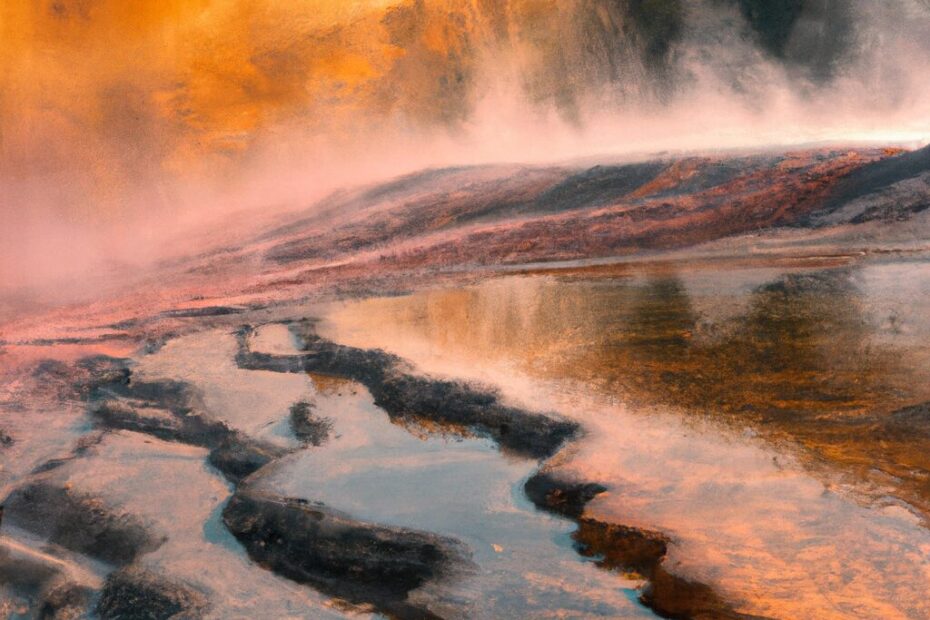Geysers are natural phenomena that have fascinated people for centuries. Among the many geysers found around the world, the Fan and Mortar Geyser stands out for its unique characteristics and impressive eruptions.
In this article, we will explore what makes this geyser special, where it can be found, and its distinct characteristics. We will also delve into the formation of geysers, the science behind their eruptions, and how to explore them safely. So, get ready to be amazed by the incredible world of Fan and Mortar Geyser!
What Are Geysers?
Geysers are natural geological features that are closely associated with geothermal activity, often found in locations such as Yellowstone National Park, showcasing the Earth’s remarkable thermal phenomena.
Geysers are rare natural formations that occur when underground water is heated by magma deep within the earth’s crust. This intense heat creates pressure, causing the water to erupt in a powerful jet of steam and hot water. Yellowstone National Park is known for its abundance of geysers, including the iconic Old Faithful. These geysers and hot springs provide a mesmerizing display of the Earth’s energy and geological processes.
What Makes Fan and Mortar Geyser Unique?
Fan and Mortar Geyser exhibit distinctive characteristics that set them apart as captivating thermal features within areas of geothermal activity.
Their unique attributes are highlighted by the impressive display of steaming water eruptions and intricate mineral formations.
The Fan Geyser is known for its broad, fan-shaped spray pattern, while the Mortar Geyser stands out with its explosive bursts reminiscent of a mortar shell.
The interconnectedness of these thermal features with geothermal activity is evident in the surrounding landscape, where the earth’s heat fuels their continuous cycles of water heating and expulsion.
Their significance lies in their role as natural indicators of the powerful forces at work beneath the Earth’s surface, drawing visitors to witness their mesmerizing displays.
Where Can Fan and Mortar Geyser Be Found?
Fan and Mortar Geyser can be found within the geysers of Yellowstone, a renowned location for geothermal exploration and research.
Located in the Upper Geyser Basin of Yellowstone National Park, Fan and Mortar Geyser stand as prime examples of the spectacular geothermal activity present in the park. This area boasts a high concentration of geysers, hot springs, and pools, drawing in researchers and visitors alike to witness the unique geothermal phenomena.
The diverse geological features and the ongoing scientific studies make this region a hub for understanding the Earth’s geothermal mysteries and the potential of geothermal energy.
What Are the Characteristics of Fan and Mortar Geyser?
Fan and Mortar Geyser are distinguished by their unique size, shape, and eruption patterns. They also differ in the temperature and pressure of their hydrothermal eruptions.
Fan Geyser is known for its distinctive tall, narrow cone-shaped structure. This unique shape allows for impressive eruptions, with jets of water and steam reaching heights of 75 to 110 feet. These eruptions are sporadic and unpredictable, typically lasting only a few minutes.
In contrast, Mortar Geyser has a wider, more cylindrical shape. This results in more uniform and predictable eruptions. The water in Mortar Geyser also maintains a higher temperature and pressure, leading to explosive eruptions that can exceed 30 feet in height.
Size and Shape
The size and shape of Fan and Mortar Geyser reflect the intricate geological formations and hydrothermal processes that contribute to their distinct appearance and functionality.
The Fan and Mortar Geyser is characterized by a wide, shallow basin known as the fan, from which water erupts in impressive displays. The mortar, or central vent, channels the heated water and steam, resulting in the dynamic eruptions.
These features are a result of the underlying geological structure, with the geyser’s formation influenced by the presence of underground reservoirs, heat sources, and the intricate interplay of hydrothermal fluids within the Earth’s crust. These geological dynamics are responsible for both the size and shape of the Fan and Mortar Geyser, showcasing the fascinating processes at work in geothermal environments.
Eruption Patterns
The eruption patterns of Fan and Mortar Geyser provide valuable insights into the rhythmic and dramatic nature of geyser eruptions, contributing to significant observations and research in the field of geyser behavior.
Distinct eruption patterns provide researchers with a unique opportunity to study the different stages of geyser activity. This includes the buildup of pressure and the awe-inspiring release of steam and water.
One example is Fan Geyser, which is known for its impressive vertical eruptions. This offers a contrast to the explosive bursts of Mortar Geyser. Studying these distinct patterns is crucial for developing predictive models and monitoring changes in geyser behavior. These findings have important implications for geothermal energy and preserving the natural landscape.
Temperature and Pressure
The temperature and pressure dynamics associated with Fan and Mortar Geyser are indicative of the underlying hydrothermal vents and the complex geothermal processes at play within the geyser’s system.
These geysers showcase remarkable variations in temperature and pressure. Fan Geyser often reaches temperatures above 200°F and produces eruptions of up to 100 feet. Meanwhile, Mortar Geyser exhibits distinct cycles of pressure build-up and release.
The interplay between these factors is crucial in understanding the sustained energy and mineral-rich waters emerging from hydrothermal vents. This shapes the unique geological and ecological landscapes associated with geothermal activity.
How Do Geysers Form?
The formation of geysers involves a combination of factors including the presence of water sources, heat sources, and a complex plumbing system beneath the Earth’s crust.
Water sources play a crucial role in geyser formation. They seep deep into the ground through porous rocks and encounter heat sources, which can come from the Earth’s mantle or nearby magma chambers.
The heat causes the water to become superheated and pressurized, seeking a way to escape. This intricate plumbing system of narrow channels and chambers allows the superheated water to rise to the surface, ultimately resulting in the awe-inspiring eruption known as a geyser.
Water Source
The water source crucial to geyser formation is often intertwined with the geological characteristics and the hydrothermal system present in the region, playing a pivotal role in the geyser’s development and activity.
Water sources for geysers can come from precipitation, surface water, or groundwater that interacts with the Earth’s heat. These sources infiltrate the ground through geological features like faults and fractures, creating reservoirs beneath the surface. The circulation of water through hot rocks and magma in the hydrothermal system generates pressure and thermal energy, resulting in the eruption of hot water and steam from geysers. It’s essential to understand the intricate connections between water sources, geology, and hydrothermal dynamics to comprehend the formation and behavior of geysers.
Heat Source
The heat source powering geyser activity is often derived from volcanic processes and geothermal energy, manifesting as a critical catalyst for the geysers’ phenomena and eruptions.
This connection reveals the intimate relationship between the Earth’s internal heat and the mesmerizing display of geysers.
Volcanic activity generates the intense heat necessary to superheat water and create the pressure needed for geyser eruptions. Geothermal energy, harnessed from the Earth’s heat, is a sustainable and renewable resource that provides an environmentally friendly alternative to traditional energy sources.
The utilization of geothermal energy in geyser formation underscores the natural symbiosis between earthly processes and the awe-inspiring natural spectacles we observe.
Plumbing System
The intricate plumbing system beneath the Earth’s surface within a geothermal field contributes to the unique geological features and the functionality of the geyser’s hydrothermal network.
This system is a complex network of fissures, fractures, and conduits that allow hot water and steam to flow from deep within the Earth’s crust to the surface, creating the spectacular geysers we see.
The formation of geysers is dependent on a delicate balance of pressure, temperature, and water supply, all of which are intricately connected to the geothermal field’s geological composition. Understanding the intricacies of this plumbing system is crucial for harnessing geothermal energy and comprehending the Earth’s natural phenomena.
What Causes the Eruptions of Fan and Mortar Geyser?
The eruptions of Fan and Mortar Geyser are triggered by a combination of factors, including thermal expansion and contraction, the presence of hydrothermal vents, and fluctuations in groundwater pressure.
The Earth’s heat causes water to expand within geyser chambers, creating pressure that leads to a release through the vent. Hydrothermal vents allow for hot and cold water exchange, contributing to pressure build-up. Surrounding geological activity can also impact eruptions through groundwater pressure fluctuations.
Understanding these processes helps us comprehend the dynamic forces behind the mesmerizing displays at geysers.
Thermal Expansion and Contraction
The thermal expansion and contraction phenomena play a significant role in the geothermal investigations and the understanding of geyser behavior, including the eruptions of Fan and Mortar Geyser.
Understanding the processes beneath the Earth’s surface is crucial, particularly in regions with significant geothermal activity. Temperature fluctuations cause materials to expand and contract, creating pressure on surrounding rock formations. This energy build-up ultimately leads to geyser eruptions. By studying the complex relationship between thermal expansion and contraction, scientists can gain valuable insights into the underlying mechanisms driving geyser activity, including the intermittent behavior of Fan and Mortar Geyser.
Hydrothermal Vents
The presence of hydrothermal vents is intertwined with crucial geologic processes and scientific studies, directly influencing the eruptions of Fan and Mortar Geyser within the broader context of geothermal science.
These vents serve as dynamic cracks on the ocean floor, emitting mineral-rich fluids and nurturing unique ecosystems. Their role in mineral deposition and energy transfer is pivotal to the Earth’s geological makeup and the sustenance of specialized organisms adapted to extreme conditions.
Scientists are intrigued by the potential insights into the origins of life that these vents offer. Understanding their impact on underwater landscapes and geothermal activity contributes significantly to our knowledge of Earth’s geology and the processes shaping our planet’s surface.
Groundwater Pressure
Fluctuations in groundwater pressure within the geothermal region are instrumental in shaping the distinctive geologic features and influencing the eruptive behavior of Fan and Mortar Geyser.
These fluctuations significantly impact the underground hydrothermal systems, causing shifts in temperature and pressure that play a pivotal role in the geyser’s activity.
The variations in groundwater pressure can lead to the formation of fissures and fractures in the bedrock, allowing for the accumulation of heated water and subsequent explosive release, creating the mesmerizing eruptions observed at Fan and Mortar Geyser.
Understanding the interplay between groundwater pressure and geologic formations is crucial in comprehending the dynamics of these natural wonders.
How Can One Explore Fan and Mortar Geyser Safely?
Exploring Fan and Mortar Geyser safely involves adhering to park rules and regulations, staying on designated paths, and being prepared for changing conditions within the geothermal sites linked to ongoing studies and research.
It is important to remember that these geothermal areas can have fluctuating temperatures and unstable ground, so it’s crucial to heed warning signs and stay within the marked boundaries.
The park regulations are in place to protect both visitors and the delicate ecological balance of the geysers. Checking the weather forecast before venturing out can help ensure a safer and more enjoyable experience. It’s also advisable to pack essentials such as water, sun protection, and sturdy footwear to navigate the terrain effectively.
Follow Park Rules and Regulations
Adhering to park rules and regulations is crucial for responsible geothermal exploration and geyser observation, promoting the safe and sustainable visitation of Fan and Mortar Geyser.
Respecting park rules is crucial for preserving the delicate geothermal ecosystem. This ensures the protection of sensitive areas and allows geyser formations to thrive. It also minimizes the risk of accidents, ensuring the safety of both visitors and the natural environment.
Following regulations also establishes boundaries to prevent disruptive activities, maintaining the serenity of the geyser site. Ultimately, compliance with these guidelines is essential for a harmonious coexistence between visitors and the geothermal wonders of Fan and Mortar Geyser.
Stay on Designated Paths
Staying on designated paths is essential to minimize the impact on geothermal phenomena and ongoing studies, ensuring the preservation of the natural environment surrounding Fan and Mortar Geyser.
This restricted access is not only for the protection of the delicate ecosystem but also to aid in the continuation of geothermal studies. It ensures that the unique geothermal features are not disturbed.
By adhering to these specified pathways, visitors can contribute to the sustainability and longevity of this incredible natural wonder. They can also gain knowledge about the geological formations and processes at work in this fascinating area.
Be Prepared for Changing Conditions
Being prepared for changing conditions is essential when interacting with geothermal resources and phenomena, ensuring the safety and responsible observation of Fan and Mortar Geyser and its surroundings.
Geothermal areas are constantly changing, with temperatures, pressure, and activity fluctuating rapidly. As a result, it’s essential to anticipate and adapt to these dynamic environments. By staying informed about geological and meteorological factors, visitors can make well-informed decisions when exploring these natural wonders.
Having a thorough understanding of potential risks and having contingency plans in place can also contribute to a safer and more enjoyable experience while observing the unique features of Fan and Mortar Geyser. It’s crucial to prioritize safety and be prepared for any changes that may occur in these unpredictable environments.
Frequently Asked Questions
1. What is the purpose of exploring Fan and Mortar Geysers?
Exploring Fan and Mortar Geysers can provide valuable information about the geological processes and structures on Earth. It can also help scientists understand how geysers function and how they contribute to the overall health of our planet.
2. Are Fan and Mortar Geysers safe to explore?
Yes, as long as proper safety precautions are taken, such as staying within designated exploration areas and following park regulations. However, it is important to remember that geysers are natural phenomena and can be unpredictable, so it is important to always proceed with caution.
3. Can anyone participate in Fan and Mortar Geyser exploration?
While anyone can visit and observe Fan and Mortar Geysers, in-depth exploration and research is typically done by trained scientists and professionals. However, there may be opportunities for citizen scientists or volunteers to assist in data collection and analysis.
4. What tools and equipment are used for Fan and Mortar Geyser exploration?
Some common tools and equipment used for Fan and Mortar Geyser exploration include seismometers, GPS devices, cameras, and water sampling kits. Drones may also be used to capture aerial footage of the geysers and surrounding areas.
5. How does exploring Fan and Mortar Geysers contribute to our understanding of Earth’s history?
Fan and Mortar Geysers are natural geological features that have been around for thousands of years. By studying them, scientists can learn more about the Earth’s past climate and how it has changed over time. This information can also help us better prepare for potential future changes in climate.
6. What are some potential risks associated with Fan and Mortar Geyser exploration?
Some risks of geyser exploration include exposure to extreme temperatures and possible geothermal hazards, such as hot springs and boiling mud pots. It is also important to be aware of the potential for falling rocks or unstable terrain in the geyser area.
Last Updated on January 26, 2024 by Jon Waraas – Originally Posted: January 25, 2024

I’m Jon Waraas, and I’ve been navigating the online world since 2006. By day, I’m the proud owner of some eCommerce gems, and by night, I’m the voice behind the adventures on Waraas.Com.
My heart, however, belongs to the wild beauty of Yellowstone National Park. I’ve got a collection of websites dedicated to sharing the wonders of this natural masterpiece. Oh, and did I mention? I’m currently building my own cabin inside the ghost town of Gilmore, Idaho – a cabin with tales to tell!
When I’m not immersed in the digital realm, you’ll find me lacing up my boots for a good hike or setting up camp under the star-studded sky.




